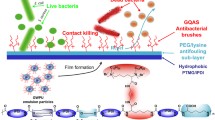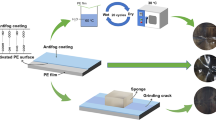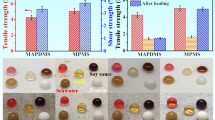Abstract
In this work, time-dependent growth of a poly(sulfobetaine methacrylate) (PSBMA) layer was realized on initiator-embedded and hydrophilic poly(N-vinylpyrrolidone)-containing (meth)acrylate resin, through subsurface-initiated atom transfer radical polymerization (SSI-ATRP). The antibiofouling performance of PSBMA graft layers with different thicknesses was investigated by testing the adhesion of different foulants, including nanoscale protein (bovine serum albumin, BSA), microscale bacteria (Gram-negative Escherichia coli (E. coli) and Gram-positive Bacillus subtilis (B. subtilis)) and diatom (Chaetoceros calcitrans). It was found that the optimal thickness for anti-adsorption of nanoscale protein is ~ 2 µm at 1 h grafting, while that for microscale bacteria and diatom anti-adhesion is ~ 10 µm at 4 h grafting. The difference in the optimal thickness for different foulants may result from the combination of effective hydration layer and surface topography. Regarding nanoscale protein, a relatively thin hydration layer may be able to provide effective steric repulsion to resist nanoscale protein adsorption. However, a relatively thick surface hydration layer associated with high steric barrier and large scale structure might be required to prevent microscale foulants from attaching. This study highlights the importance of graft layer thickness, which is related to the thickness of surface hydration layer, and topography in governing the antibiofouling performance against different foulants.
Graphic abstract










Similar content being viewed by others
References
Dundua A, Franzka S, Ulbricht M (2016) Improved antifouling properties of polydimethylsiloxane films via formation of polysiloxane/polyzwitterion interpenetrating networks. Macromol Rapid Commun 37:2030–2036
Shivapooja P, Yu Q, Orihuela B, Mays R, Rittschof D, Genzer J, López GP (2015) Modification of silicone elastomer surfaces with zwitterionic polymers: short-term fouling resistance and triggered biofouling release. ACS Appl Mater Interfaces 7:25586–25591
Chen S, Li L, Chao Z, Jie Z (2010) Surface hydration: principles and applications toward low-fouling/nonfouling biomaterials. Polymer 51:5283–5293
Schultz MP, Bendick JA, Holm ER, Hertel WM (2011) Economic impact of biofouling on a naval surface ship. Biofouling 27:87–98
Callow JA, Callow ME (2011) Trends in the development of environmentally friendly fouling-resistant marine coatings. Nat Commun 2:1–10
Lejars M, Margaillan A, Bressy C (2012) Fouling release coatings: a nontoxic alternative to biocidal antifouling coatings. Chem Rev 112:4347–4390
Bloecher N, Olsen Y, Guenther J (2013) Variability of biofouling communities on fish cage nets: a 1-year field study at a Norwegian salmon farm. Aquaculture 416:302–309
Fitridge I, Dempster T, Guenther J, De NR (2012) The impact and control of biofouling in marine aquaculture: a review. Biofouling 28:649–669
Bixler GD, Bhushan B (2012) Biofouling: lessons from nature. Philos Trans R Soc A 370:2381–2417
Nir S, Reches M (2016) Bio-inspired antifouling approaches: the quest towards nontoxic and non-biocidal materials. Curr Opin Biotechnol 39:48–55
Schumacher JF, Aldred N, Callow ME, Finlay JA, Callow JA, Clare AS, Brennan AB (2007) Species-specific engineered antifouling topographies: correlations between the settlement of algal zoospores and barnacle cyprids. Biofouling 23:307–317
Brzozowska AM, Parra-Velandia FJ, Quintana R, Xiaoying Z, Lee SS, Chin- Sing L, Jańczewski D, Teo SLM, Vancso JG (2014) Biomimicking micropatterned surfaces and their effect on marine biofouling. Langmuir 30:9165–9175
Genzer J, Efimenko K (2006) Recent developments in superhydrophobic surfaces and their relevance to marine fouling: a review. Biofouling 22:339–360
Wan F, Pei X, Yu B, Ye Q, Zhou F, Xue Q (2012) Grafting polymer brushes on biomimetic structural surfaces for anti-algae fouling and foul release. ACS Appl Mater Interfaces 4:4557–4565
Bixler GD, Bhushan B (2012) Bioinspired rice leaf and butterfly wing surface structures combining shark skin and lotus effects. Soft Matter 8:11271–11284
Cheng M, Zhang S, Dong H, Han S, Wei H, Shi F (2015) Improving the durability of a drag-reducing nanocoating by enhancing its mechanical stability. ACS Appl Mater Interfaces 7:4275–4282
Wei C, Zhang G, Zhang Q, Zhan X, Chen F (2016) Silicone oil-infused slippery surfaces based on sol-gel process-induced nanocomposite coatings: a facile approach to highly stable bioinspired surface for biofouling resistance. ACS Appl Mater Interfaces 8:34810–34819
Omae I (2003) Organotin antifouling paints and their alternatives. Appl Organomet Chem 17:81–105
Rodríguez B, Oztürk D, Rosales M, Flores M, García A (2018) Antibiofouling thin-film composite membranes (TFC) by in situ formation of Cu-(m-phenylenediamine) oligomer complex. J Mater Sci 53:6325–6338. https://doi.org/10.1007/s10853-018-2039-4
Detty MR, Ciriminna R, Bright FV, Pagliaro M (2014) Environmentally benign sol–gel antifouling and foul-releasing coatings. Acc Chem Res 47:678–687
Wang Q, Xie D, Chen J, Liu G, Yu M (2020) Superhydrophobic paper fabricated via nanostructured titanium dioxide-functionalized wood cellulose fibers. J Mater Sci 55:7084–7094. https://doi.org/10.1007/s10853-020-04489-7
Su X, Hao D, Li Z, Guo X, Jiang L (2019) Design of hierarchical comb hydrophilic polymer brush (HCHPB) surfaces inspired by fish mucus for anti-biofouling. J Mater Chem B 7:1322–1332
Swar S, Zajícová V, Müllerová J, Šubrtová P, Horáková J, Dolenský B, Řezanka M, Stibor I (2018) Effective poly (ethylene glycol) methyl ether grafting technique onto Nylon 6 surface to achieve resistance against pathogenic bacteria Staphylococcus aureus and Pseudomonas aeruginosa. J Mater Sci 53:14104–14120. https://doi.org/10.1007/s10853-018-2636-2
Ma H, Hyun J, Stiller P, Chilkoti A (2004) “Non-fouling” oligo (ethylene glycol)-functionalized polymer brushes synthesized by surface-initiated atom transfer radical polymerization. Adv Mater 16:338–341
Schilp S, Rosenhahn A, Pettitt ME, Bowen J, Callow ME, Callow JA, Grunze M (2009) Physicochemical properties of (ethylene glycol)-containing self-assembled monolayers relevant for protein and algal cell resistance. Langmuir 25:10077–10082
Indrani B, Pangule RC, Kane RS (2011) Antifouling coatings: recent developments in the design of surfaces that prevent fouling by proteins, bacteria, and marine organisms. Adv Mater 23:690–718
Yang W, Zhang L, Wang S, White AD, Jiang S (2009) Functionalizable and ultra stable nanoparticles coated with zwitterionic poly (carboxybetaine) in undiluted blood serum. Biomaterials 30:5617–5621
Zhao W, Zhu Y, Zhang J, Xu T, Li Q, Guo H, Zhang J, Lin C, Zhang L (2018) A comprehensive study and comparison of four types of zwitterionic hydrogels. J Mater Sci 53:13813–13825. https://doi.org/10.1007/s10853-018-2535-6
Li G, Cheng G, Xue H, Chen S, Zhang F, Jiang S (2008) Ultra low fouling zwitterionic polymers with a biomimetic adhesive group. Biomaterials 29:4592–4597
Zhang Y, Wang Z, Lin W, Sun H, Wu L, Chen S (2013) A facile method for polyamide membrane modification by poly(sulfobetaine methacrylate) to improve fouling resistance. J Membr Sci 446:164–170
Dai J, Dong Y, Yu C, Liu Y, Teng X (2018) A novel Nafion-g-PSBMA membrane prepared by grafting zwitterionic SBMA onto Nafion via SI-ATRP for vanadium redox flow battery application. J Membr Sci 554:324–330
Sun X, Li Q, Guo Z, Wang K, Gui T, Gao C (2019) Study on the core-shell reversion of PSBMA-b-PLMA nanoparticles for the fabrication of antifouling coatings. ACS Appl Mater Interfaces 11:21323–21333
Jiang J, Zhang P, Zhu L, Zhu B, Xu Y (2015) Improving antifouling ability and hemocompatibility of poly (vinylidene fluoride) membranes by polydopamine-mediated ATRP. J Mater Chem B 3:7698–7706
Yang W, Chen S, Cheng G, Vaisocherova H, Xue H, Li W, Zhang J, Jiang S (2008) Film thickness dependence of protein adsorption from blood serum and plasma onto poly (sulfobetaine)-grafted surfaces. Langmuir 24:9211–9214
Zhao C, Li L, Wang Q, Yu Q, Zheng J (2011) Effect of film thickness on the antifouling performance of poly (hydroxy-functional methacrylates) grafted surfaces. Langmuir 27:4906–4913
Razza N, Castellino M, Sangermano M (2017) Fabrication of Janus particles via a “photografting-from” method and gold photoreduction. J Mater Sci 52:13444–13454. https://doi.org/10.1007/s10853-017-1459-x
Liu H, Ma Z, Yang W, Pei X, Zhou F (2019) Facile preparation of structured zwitterionic polymer substrate via sub-surface initiated atom transfer radical polymerization and its synergistic marine antifouling investigation. Eur Polym J112:146–152
Yu X, Yang Y, Yang W, Wang X, Liu X, Zhou F, Zhao Y (2020) Solvent-driven migration of highly polar monomers into hydrophobic PDMS produces thick graft layer via subsurface initiated ATRP for efficient antibiofouling. ChemComm. https://doi.org/10.1039/d0cc00768d
Matyjaszewski K, Gaynor SG, Kulfan A, Podwika M (1997) Preparation of hyperbranched polyacrylates by atom transfer radical polymerization. 1. Acrylic AB* monomers in “living” radical polymerizations. Macromolecules 30:5192–5194
Matyjaszewski K, Gaynor SG, Müller AH (1997) Preparation of hyperbranched polyacrylates by atom transfer radical polymerization. 2. Kinetics and mechanism of chain growth for the self-condensing vinyl polymerization of 2-((2-bromopropionyl) oxy) ethyl acrylate. Macromolecules 30:7034–7041
Patil AJ, Zhao Y, Liu X, Wang X (2017) Durable superhydrophobic and antimicrobial cotton fabrics prepared by electrostatic assembly of polyhexamethylene biguanide and subsequent hydrophobization. Text Res J 88:1788–1799
Chen X, He X, Suo X, Huang J, Gong Y, Liu Y, Li H (2016) Effect of surface topological structure and chemical modification of flame sprayed aluminum coatings on the colonization of Cylindrotheca closterium on their surfaces. Appl Surf Sci 388:385–391
Zhang Z, Finlay JA, Wang L, Gao Y, Callow JA, Callow ME, Jiang S (2009) Polysulfobetaine-grafted surfaces as environmentally benign ultralow fouling marine coatings. Langmuir 25:13516–13521
Yu ZJ, Kang ET, Neoh KG (2002) Electroless plating of copper on polyimide films modified by surface grafting of tertiary and quaternary amines polymers. Polymer 43:4137–4146
Ibrahim GS, Isloor AM, Asiri AM, Ismail N, Ismail AF, Ashraf GM (2017) Novel, one-step synthesis of zwitterionic polymer nanoparticles via distillation-precipitation polymerization and its application for dye removal membrane. Sci Rep 7:1–16
Xiang T, Lu T, Wang R, Wang C, Sun SD, He HB, Zhao CS (2015) Improved antifouling properties and blood compatibility of 3-methacryloxypropyl trimethoxysilane-based zwitterionic copolymer modified composite membranes via in situ post-crosslinking copolymerization. RSC Adv 5:23229–23238
Yang Z, Zhang S, Tarabara VV, Bruening ML (2018) Aqueous swelling of zwitterionic poly (sulfobetaine methacrylate) brushes in the presence of ionic surfactants. Macromolecules 51:1161–1171
Wang S, Chen K, Li L, Guo X (2013) Binding between proteins and cationic spherical polyelectrolyte brushes: effect of pH, ionic strength, and stoichiometry. Biomacromol 14:818–827
Yang W, Zhang R, Wu Y, Pei X, Liu Y, Zhou F (2018) Enhancement of graft density and chain length of hydrophilic polymer brush for effective marine antifouling. J Appl Polym Sci 135:46232–46240
Kitano H, Suzuki H, Kondo T, Sasaki K, Iwanaga S, Nakamura M, Ohno K, Saruwatari Y (2011) Image printing on the surface of anti-biofouling zwitterionic polymer brushes by ion beam irradiation. Macromol Biosci 11:557–564
Goda T, Konno T, Takai M, Moro T, Ishihara K (2006) Biomimetic phosphorylcholine polymer grafting from polydimethylsiloxane surface using photo-induced polymerization. Biomaterials 27:5151–5160
Zhang Y, Hu H, Pei X, Liu Y, Ye Q, Zhou F (2017) Polymer brushes on structural surfaces: a novel synergistic strategy for perfectly resisting algae settlement. Biomater Sci 5:2493–2500
Carr LR, Xue H, Jiang S (2011) Functionalizable and nonfouling zwitterionic carboxybetaine hydrogels with a carboxybetaine dimethacrylate crosslinker. Biomaterials 32:961–968
Acknowledgements
X.Y. gratefully acknowledges the financial support from the Chinese Scholarship Council under Grant 201606740077. Support from Kim, the manager of Victorian Shellfish Hatchery, Queenscliff Centre, Australia, in the diatom culture is also greatly acknowledged.
Author information
Authors and Affiliations
Corresponding authors
Ethics declarations
Conflict of interest
The authors declare that they have no conflict of interest.
Additional information
Publisher's Note
Springer Nature remains neutral with regard to jurisdictional claims in published maps and institutional affiliations.
Electronic supplementary material
Below is the link to the electronic supplementary material.
10853_2020_5055_MOESM1_ESM.docx
The following files are available free of charge. 1H NMR spectra of initiator BIEM, ATR-FTIR of synthesized resin, swelling ratio of resin, fluorescence microscopy images of FITC-BSA adsorbed resin, images of E.coli and B. subtilis colonies on ager plate, and optical microscopy images of diatom adhered resin (PDF). (DOCX 7364 kb)
Rights and permissions
About this article
Cite this article
Yu, X., Yang, W., Yang, Y. et al. Subsurface-initiated atom transfer radical polymerization: effect of graft layer thickness and surface morphology on antibiofouling properties against different foulants. J Mater Sci 55, 14544–14557 (2020). https://doi.org/10.1007/s10853-020-05055-x
Received:
Accepted:
Published:
Issue Date:
DOI: https://doi.org/10.1007/s10853-020-05055-x




